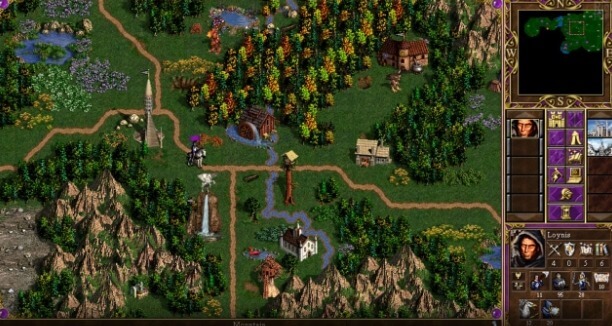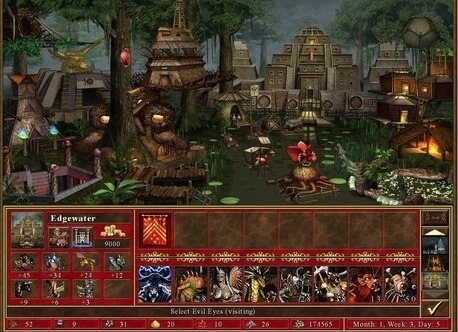Gameplay consists of strategic exploration on the world map and tactical turn-based combat. As with the series in general, the player controls a number of "heroes" who act as generals and command troops comprising various types of creatures inspired by myth and legend. The player can complete or "win" a map by completing the objectives set out by the creator of the map. Objectives may include conquering all the towns in the map, gathering a set amount of resources, or piecing together a puzzle to find the Grail artifact. If a player loses all their heroes and towns, they will lose the game.
There are two "layers" to the world map: the aboveground and the underground. There are typically subterranean gateways that lead to and from the underground. Maps are filled with a huge variety of buildings, treasures, monsters, mines and so forth that reward extensive exploration. At the very least, a player must locate mines and flag them (whereupon they provide constant resources), since these resources are required to develop towns. The player must also develop his heroes' skills, both by battling creatures (and enemy heroes) and by acquiring artifacts or visiting special locations. Heroes are given a choice of skills to upgrade upon leveling up, as well as becoming better at combat or using magic. The skills must be chosen carefully, since they are permanent and only a limited number of skills can be learned.
Towns
The player's towns serve many functions, but most importantly they allow recruitment of creatures to form armies. Towns also provide funds, new spells and a fortified location to make a last stand against an invading enemy hero. To build new structures within a town requires gold and usually one or more type of resource. Wood and ore are needed for most structures, but more expensive buildings will also require rarer resources (mercury, crystal, gems or sulfur). All factions require a disproportionate quantity of just one of these special resources, making the acquisition of a corresponding mine essential to victory. This same resource is also needed when hiring the most powerful creatures available to that faction. Each faction also has a handful of unique structures available only to them.
If a player finds the Grail artifact, he can deliver it to a town to make that town the Grail's permanent home by creating a special structure. The Grail bestows greatly increased creature growth and weekly income, in addition to a bonus unique to the town.
The eight different castles available in Heroes III are classified as good, evil, and neutral. Each town has seven basic creatures, each of which can be upgraded to a more powerful variant. Each town also features two associated hero types: one that leans more toward might (combat), and one that leans more toward magic.
Plot
The game's story unfolds primarily through a series of seven playable campaigns, all set upon the continent of Antagarich. During the campaigns, the story is told from alternating points of view, giving players the opportunity to play as each of the town alignments.
Following the disappearance of King Roland Ironfist of Enroth prior to Might and Magic VI: The Mandate of Heaven, his wife, Queen Catherine, is left to rule the realm. In the meantime, her father, King Gryphonheart of Erathia, is assassinated. Without their beloved King, the kingdom of Erathia falls to the dark forces of Nighon and Eeofol. Queen Catherine returns home to Antagarich seeking to rally the people of her homeland and lead them against the evil that has ravaged their nation.
Erathia's capital of Steadwick is sacked by the dungeon lords of Nighon and the Kreegans of Eeofol. Meanwhile, the nations of Tatalia and Krewlod skirmish at the western border, seizing the chance to expand their territory. Catherine's first task is to establish a foothold in the conquered kingdom by enlisting the aid of allies. The wizards of Bracada and the elves of AvLee answer her call, and together they push towards Steadwick and eventually retake it, quickly quelling the border war in the west. Soon after, Lucifer Kreegan, a commander in the Eeofol armies, sends an envoy to Erathia claiming that Roland Ironfist is captive within their territories. AvLee invades Eeofol, but fails to rescue Roland, who is transported to their northern holdings. Afterwards, Catherine invades Nighon, pushing the dungeon armies back to their island home.
In the meantime, the necromancers of Deyja, having been responsible for the assassination of King Gryphonheart, plot to revive his corpse as a lich. They plan to use his wisdom in leading their own armies of the undead. However, King Gryphonheart's will proves too much for the necromancers even in his corrupted state, and he becomes a rogue lich. Having little other recourse, Queen Catherine is forced to ally herself with the necromancers and together they set out to destroy the lich of King Gryphonheart before he becomes too powerful.
A final bonus campaign, accessible only after the main campaigns are complete, tells the story of separatists living in the Contested Lands, a war-torn border between Erathia and AvLee. Tired of the skirmishes that bring unrest to their homelands, they join together to fight for independence from the two large kingdoms. It is later implied that this rising was orchestrated by Archibald Ironfist, the antagonist of Heroes of Might and Magic II.
Reception
Heroes III was praised by critics, receiving an average score of 87% in GameRankings.
Next Generation reviewed the PC version of the game, rating it four stars out of five, and stated that "While realtime strategy withers on the vine, with many recent releases lackluster at best, HoMM reminds us that turn-based play is alive and well. In fact, it's hard to remember why people said turn-based was dead in the first place."
Computer Gaming World's Robert Coffey said that the game "expands upon the insanely addictive play of the previous edition, retaining the core gameplay while enhancing almost every facet of the game". He continued to say that the game is "mind-boggling in its depth", but criticized its uneven campaign pacing and "sluggish" connection speeds during online play. He concluded: "Ultimately, the rewards of Heroes of Might and Magic III far outweigh its few drawbacks. ... This is a game that strategy fans should absolutely be playing".
Heroes of Might and Magic III was a finalist for Computer Games Strategy Plus's 1999 "Strategy Game of the Year" prize, although it lost to RollerCoaster Tycoon. The editors wrote that Heroes of Might and Magic III "keeps this series running on all cylinders. There’s nothing radically different here, but what would you change?"























